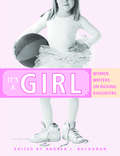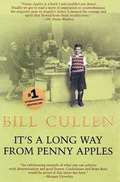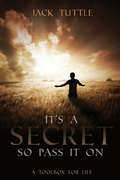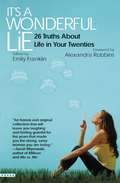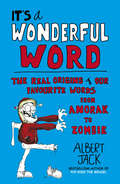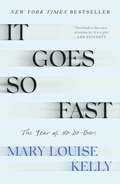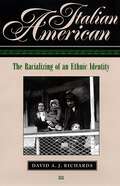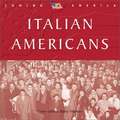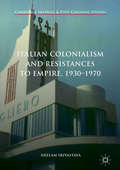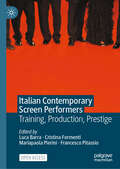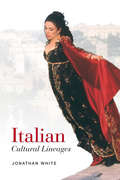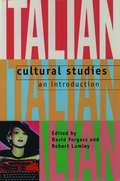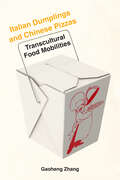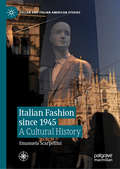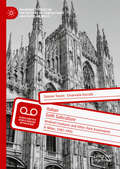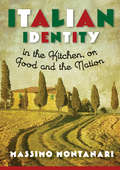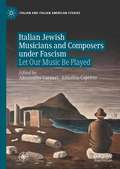- Table View
- List View
It's a Girl: Women Writers on Raising Daughters
by Andrea J. BuchananThe most popular question any pregnant woman is asked - aside from "When are you due?" - has got to be "Are you having a girl or a boy?" When author Andrea Buchanan was pregnant with her daughter, she was thrilled to be expecting a girl. Some people were happy for her; visions of flouncy pink dresses and promises of mother-daughter bonding were the predictable responses. Other people, though, were concerned: "Is your husband OK with that?" "You can try again." "Girls are tough." This mixed message led her to explore the issue herself, with help from her fellow writers and moms, many of whom had had the same experience. As she did in It's a Boy: Women Writers on Raising Sons, Buchanan and her contributors take on what it's really like to raise a child-in this case, a girl-from babyhood to adulthood.It's a Girl, is a wide-ranging, often humorous, and honest collection of essays about the experience of the mother-daughter bond, taking on topics like "princess power" ("Shining, Shimmering, Splendid"), adding a girl to a brood of boys ("Confessions of a Tomboy Mom"), dealing with a daughter's eating disorder ("The Food Rules"), and mothering "hardcore mini-feminists" ("Tough Girls").
It's a Long Way from Penny Apples
by Bill Cullen[From the back cover] "Tis better to be born lucky than rich. ... There are many tragic stories in Ireland of those who have succumbed to the despair of abject poverty, those who were unable to save themselves or their loved ones from the harsh realities of oppression. But It's a Long Way from Penny Apples is a different view of the Irish experience, one man's journey out of the grinding poverty that held an entire generation of Irishmen in its thrall. Born and bred in the rough inner city slums of Summerhill in Dublin, Bill was one of fourteen children. Through hard work and determination, Bill went from selling flowers and newspapers on the street to owning the biggest Ford dealership in Ireland, and eventually became a multimillionaire. Bill Cullen's story is an account of incredible poverty and deprivation in the Dublin slums--and incredible success. It highlights the frustration of a father and mother feeling their relationship crumble as they fight to give their children a better life. It's a story of courage, joy, and happiness--of how a mother gave inspiration and values to her children, saying to them, "The best thing I can give you is the independence to stand on your own feet." "The story of a Dubliner reflecting with stunning honesty on his city and his past. With characters that leap off the page, it combines blunt realism with the everyday humor of Northside Dublin life. An incredible book." --Bertie Ahern, T.D., Taoiseach (prime minister) of Ireland
It's a Secret, So Pass it On
by Jack L. TuttleInsight. Peace. Connection. Happiness. Answers. Drawing on lessons, experiences, and information garnered across a lifetime, "It's a Secret, So Pass it On" illuminates that the spiritual world is closer than you think. The connections humans so fervently search for, year to experience, are within us, within Nature. However, you first have to get beyond your self-imposed limits, your predetermined expectations---you have to open your mind and soul to the possibility of connection. "It's a Secret, So Pass it On," will help you balance this eternal equation of life, peace, and spirituality. Discover your true self and strengthen your internal and external connections through this transformational journey.
It's a Wonderful Lie: 26 Truths About Life in Your Twenties
by Emily FranklinIn this original collection, critically acclaimed female writers pull back the curtain on being twenty-something. Entertaining and enlightening, this anthology speaks honestly about that unique time in life when expectations are not always realized, yet surprises are plentiful and thrilling.
It's a Wonderful Word: The Real Origins of Our Favourite Words
by Albert JackDid you know that an assassin is a hashish-eater and a yokel a country woodpecker? That Dr Mesmer mesmerised patients back to health or that Samuel Pepys enjoyed a good game of handicap? While we're at it, what have spondulics to do with spines or lawyers with avocados?In It's a Wonderful Word, bestselling author Albert Jack collects over 500 of the strangest, funniest-sounding and most delightful words in the English language, and traces them back to their often puzzling origins. While brushing up on your gibberish or gobbledygook, discover why bastards should resent travelling salesmen, why sheets should remain on tenterhooks and why you should never set down a tumbler before finishing your drink.From blotto to bamboozle and from claptrap to quango, Albert Jack's addictive anecdotes bring the world's most colourful language to life and are guaranteed to surprise and entertain.
It. Goes. So. Fast.: The Year of No Do-Overs
by Mary Louise KellyAn Instant New York Times Bestseller“This voice-driven, relatable, heartfelt and emotional story will make any parent tear up.”—Good Morning America, “15 Delightful Books Perfect for Spring Reading”Operating Instructions meets Glennon Doyle in this new book by famed NPR reporter Mary Louise Kelly that is destined to become a classic—about the year before her son goes to college—and the joys, losses and surprises that happen along the way.The time for do-overs is over.Ever since she became a parent, Mary Louise Kelly has said “next year.” Next year will be the year she makes it to her son James’s soccer games (which are on weekdays at 4 p.m., right when she is on the air on NPR’s All Things Considered, talking to millions of listeners). Drive carpool for her son Alexander? Not if she wants to do that story about Ukraine and interview the secretary of state. Like millions of parents who wrestle with raising children while pursuing a career, she has never been cavalier about these decisions. The bargain she has always made with herself is this: this time I’ll get on the plane, and next year I’ll find a way to be there for the mom stuff.Well, James and Alexander are now seventeen and fifteen, and a realization has overtaken Mary Louise: her older son will be leaving soon for college. There used to be years to make good on her promises; now, there are months, weeks, minutes. And with the devastating death of her beloved father, Mary Louise is facing act three of her life head-on. Mary Louise is coming to grips with the reality every parent faces. Childhood has a definite expiration date. You have only so many years with your kids before they leave your house to build their own lives. It’s what every parent is supposed to want, what they raise their children to do. But it is bittersweet. Mary Louise is also dealing with the realities of having aging parents. This pivotal time brings with it the enormous questions of what you did right and what you did wrong. This chronicle of her eldest child’s final year at home, of losing her father, as well as other curve balls thrown at her, is not a definitive answer―not for herself and certainly not for any other parent. But her questions, her issues, will resonate with every parent. And, yes, especially with mothers, who are judged more harshly by society and, more important, judge themselves more harshly. What would she do if she had to decide all over again? Mary Louise’s thoughts as she faces the coming year will speak to anyone who has ever cared about a child or a parent. It. Goes. So. Fast. is honest, funny, poignant, revelatory, and immensely relatable.
Italian American: The Racializing of an Ethnic Identity
by David A.J. RichardsWhen southern Italians began emigrating to the U.S. in large numbers in the 1870s-part of the "new immigration" from southern and eastern rather than northern Europe-they were seen as racially inferior, what David A. J. Richards terms "nonvisibly" black. The first study of its kind, Italian American explores the acculturation process of Italian immigrants in terms of then-current patterns of European and American racism. Delving into the political and legal context of flawed liberal nationalism both in Italy (the Risorgimento) and the United States (Reconstruction Amendments), Richards examines why Italian Americans were so reluctant to influence depictions of themselves and their own collective identity. He argues that American racism could not have had the durability or political power it has had either in the popular understanding or in the corruption of constitutional ideals unless many new immigrants, themselves often regarded as racially inferior, had been drawn into accepting and supporting many of the terms of American racism. With its unprecedented focus on Italian American identity and an interdisciplinary approach to comparative culture and law, this timely study sheds important light on the history and contemporary importance of identity and multicultural politics in American political and constitutional debate.
Italian Americans (Coming To America)
by Barry MorenoHere are vivid evocations of New York’s Little Italy and San Francisco’s Italian community around Fisherman’s Wharf, along with the warm family life and neighborhood festivals, the wonderful Italian cuisine, the merchants and tradesmen, the underworld figures, the political leaders, and much more. Brief biographies touch on the lives of physicist Enrico Fermi, politicians Fiorello LaGuardia and Rudolph Giuliani, sportsman Joe DiMaggio, and many others.
Italian Colonialism and Resistances to Empire, 1930-1970
by Neelam SrivastavaThis book provides an innovative cultural history of Italian colonialism and its impact on twentieth-century ideas of empire and anti-colonialism. In October 1935, Mussoliniʼs army attacked Ethiopia, defying the League of Nations and other European imperial powers. The book explores the widespread political and literary responses to the invasion, highlighting how Pan-Africanism drew its sustenance from opposition to Italy's late empire-building, and reading the work of George Padmore, Claude McKay, and CLR James alongside the feminist and socialist anti-colonial campaigner Sylvia Pankhurst's broadsheet, New Times and Ethiopia News. Extending into the postwar period, the book examines the fertile connections between anti-colonialism and anti-fascism in Italian literature and art, tracing the emergence of a "resistance aesthetics" in works such as The Battle of Algiers and Giovanni Pirelli's harrowing books of testimony about Algeria's war of independence, both inspired by Frantz Fanon. This book will interest readers passionate about postcolonial studies, the history of Italian imperialism, Pan-Africanism, print cultures, and Italian postwar culture.
Italian Contemporary Screen Performers: Training, Production, Prestige
by Luca Barra Francesco Pitassio Cristina Formenti Mariapaola PieriniBringing together performance studies, celebrity studies, and media production studies, this open access book offers a comprehensive understanding of the multi-layered condition of film and television performers within the contemporary Italian screen media landscape. By focusing on a selection of stars who reached success from 2000 onwards, the collection highlights how the renewal of the Italian media industry in the late 1990s impacted different aspects of Italian screen performers’ professional lives, from training to promotion and validation strategies.
Italian Courts and European Culture (Renaissance History, Art and Culture)
by Marcello FantoniBetween the fifteenth and the eighteenth century, princely courts dominated the Italian political scene. These courts were effervescent centers of cultural production. As such, they became a model for European monarchies who imported Italian courtly forma del vivere (‘style of life’) to legitimize their power and to define social status. This phenomenon included architecture and painting, theater and music, manners and aesthetics, and all the objects, behaviors and beliefs that contributed to homogenize European culture in the age of the Old Regime. It involved a hemorrhage of art and a continuous circulation of people, texts and symbols. The foundational material for this process was classicism and its purpose was political. This delineates a new geography and chronology of a truly European cultural history. It also provides the key traits for the European cultural identity. This book offers a comprehensive reconstruction of the Italian geo-political map focused on courts (thirteenth - seventeenth centuries) and analyses the homogeneity of political forms and of the Italian Christian-Classicist culture.
Italian Cultural Lineages
by Jonathan WhiteIn Italian Cultural Lineages, Jonathan White seeks answers to the elusive questions: what is Italian culture and what is the Italian identity? By tracing Italian life and art through several themes ? viewing and spectatorship, fantasy, passion, justice, reputation, and lifestyles ? White offers new ways of perceiving an ancient cultural tradition in the twenty-first century. In doing so, he challenges readers to discern rich poetic seams that bind together his varied subject matter. Italian Cultural Lineages is primarily concerned with factors that unify Italians, however geographically dispersed they may be. Drawing on extensive archival and historical research, White shows how oftentimes Italian cultural traditions that appear to be extinct are, in fact, enduring ? pushed out of the mainstream or submerged at some given point in history, only to re-surface and take on new meanings at a later date. Other, more marginal currents might disrupt and fragment Italian identity, politically and socially. However, White proposes that the challenge to Italy in these new and difficult lessons in tolerance has the potential to produce a much stronger culture, primed to welcome the marginal into an expanded spirit of all that counts as Italian. Ideally suited to course use, and written with great lucidity, Italian Cultural Lineages will prove fascinating to students, academics, and general readers alike.
Italian Cultural Studies: An Introduction
by David Forgacs Robert LumleyThis illustrated introduction to the study of modern Italian culture brings together specialists in the fields of language; politics; religious, ethnic, and gender identities; the mass media; cultural policy; and movie stars. In four thematic sections, the contributors elucidate their own slice of Italian culture. Geographies questions received notions of the Italian nation, the family, the "South" and corruption; it also looks at anthropological approaches to culture and at Italy's linguistic pluralism. Identities examines gender, religion, politics, and ethnicity as a means by which people define themselves and others. Media explores the press, literature, television, and cinema. Culture and Society brings together historical analyses of cultural policy, stars and style, and popular music. The book includes guidance for further reading and a chronology of political and cultural events since 1900.
Italian Days
by Barbara Grizzuti Harrison"Italian Days" is one of the richest and most absorbing travel books written--a journey that traverses the Italian peninsula and immerses readers in a culture which provides the reader with a definition of the good life. "Harrison's wonderful journal will make you update your passport and dream of subletting your job, home, etc. . . . "
Italian Dumplings and Chinese Pizzas: Transcultural Food Mobilities (Critical Studies in Italian Migrations)
by Gaoheng ZhangDesigns a novel analytical framework to approach transcultural food mobilities, a culinary phenomenon that has been with us for decades as a result of colonialism and globalization Why is it surprising for some of us to read the pairing of “Chinese” with “pizzas” and “Italian” with “dumplings,” such as proposed in the book’s title? After all, in some regions of the two countries, Italians eat frequently dumplings, and Chinese frequently make baked, steamed, or fried flatbread with toppings or fillings. Furthermore, when dumplings are made in Italy by Chinese migrants or Chinese Italians, or when pizzas are made in China by Italian migrants, Chinese Italians, or Chinese without apparent ties with Italy, are these culinary products Chinese, Italian, Chinese-Italian, or something else? Why do we need to care for such labeling dilemmas? This book shows how China-Italy food mobilities relayed in popular culture helped forge Chinese and Italians’ socioeconomic identities in recent decades by fundamentally shaping contemporary Chinese and Italian consumer cultures. This book addresses China-Italy food cultures against the backdrops of two epoch-making socioeconomic processes. During the 1980s, Chinese cuisine became the first non-European food widely available in Italy, thanks to the widespread presence of Chinese eateries. Only American fast food, which established itself in Italy around the same time, enjoyed comparable popularity as a destination for Italian culinary tourism. Meanwhile, in the early 1990s, together with American hamburgers and fried chicken, the American food chain Pizza Hut’s pizzas and spaghetti were the first non-Asian foods that post-Mao Chinese customers recognized as “Western.” The book proposes a critical framework that analyzes transcultural food mobilities by seriously assessing the confluence of diverse mobilities and their impact on food cultures. Ultimately, the study shows that a sophisticated interpretation of transcultural food mobilities can help address alterity and build understanding in a world of increasing political and cultural polarization.
Italian Ecocinema: Beyond the Human (New Directions in National Cinemas)
by Elena PastEcocriticism and film studies unite in this examination of five Italian films and the environmental questions they raise.Entangled in the hybrid fields of ecomedia studies and material ecocriticism, Elena Past examines five Italian films shot on location and ponders the complex relationships that the production crews developed with the filming locations and the nonhuman cast members. She uses these films—Red Desert (1964), The Winds Blows Round (2005), Gomorrah (2008), Le quattro volte (2010), and Return to the Aeolian Islands (2010)—as case studies to explore pressing environmental questions such as cinema’s dependence on hydrocarbons, the toxic waste crisis in the region of Campania, and our reliance on the nonhuman world. Dynamic and unexpected actors emerge as the subjects of each chapter: playful goats, erupting volcanoes, airborne dust particles, fluid petroleum, and even the sound of silence. Based on interviews with crew members and close readings of the films themselves, Italian Ecocinema Beyond the Human theorizes how filmmaking practice—from sound recording to location scouting to managing a production—helps uncover cinema’s ecological footprint and its potential to open new perspectives on the nonhuman world.“[Past] uniquely and innovatively combines film studies and material ecocriticism with a focus on Italy. Such weaving of tales brings the films to life and reads them as ecological documents and Italian stories.” —Heather I. Sullivan, author of The Intercontextuality of Self and Nature in Ludwig Tieck’s Early Works“A timely and incisive study that interrogates a new, though growing, trend in film criticism and makes an important and rich contribution to Italian film studies, Italian cultural studies, and ecocriticism.” —Bernadette Luciano, author (with Susanna Scarparo) of Reframing Italy: New Trends in Italian Women’s Filmmaking“Part memoir, part close analysis of the films themselves, and illustrated with numerous excellent frame grabs, Past’s book casts a dreamlike spell as it contemplates the past, present, and future of the cinema and moves smoothly between environmental issues and aesthetic and practical concerns.” —Choice
Italian Ecocinema: Beyond the Human (New Directions in National Cinemas)
by Elena PastEcocriticism and film studies unite in this examination of five Italian films and the environmental questions they raise.Entangled in the hybrid fields of ecomedia studies and material ecocriticism, Elena Past examines five Italian films shot on location and ponders the complex relationships that the production crews developed with the filming locations and the nonhuman cast members. She uses these films—Red Desert (1964), The Winds Blows Round (2005), Gomorrah (2008), Le quattro volte (2010), and Return to the Aeolian Islands (2010)—as case studies to explore pressing environmental questions such as cinema’s dependence on hydrocarbons, the toxic waste crisis in the region of Campania, and our reliance on the nonhuman world. Dynamic and unexpected actors emerge as the subjects of each chapter: playful goats, erupting volcanoes, airborne dust particles, fluid petroleum, and even the sound of silence. Based on interviews with crew members and close readings of the films themselves, Italian Ecocinema Beyond the Human theorizes how filmmaking practice—from sound recording to location scouting to managing a production—helps uncover cinema’s ecological footprint and its potential to open new perspectives on the nonhuman world.“[Past] uniquely and innovatively combines film studies and material ecocriticism with a focus on Italy. Such weaving of tales brings the films to life and reads them as ecological documents and Italian stories.” —Heather I. Sullivan, author of The Intercontextuality of Self and Nature in Ludwig Tieck’s Early Works“A timely and incisive study that interrogates a new, though growing, trend in film criticism and makes an important and rich contribution to Italian film studies, Italian cultural studies, and ecocriticism.” —Bernadette Luciano, author (with Susanna Scarparo) of Reframing Italy: New Trends in Italian Women’s Filmmaking“Part memoir, part close analysis of the films themselves, and illustrated with numerous excellent frame grabs, Past’s book casts a dreamlike spell as it contemplates the past, present, and future of the cinema and moves smoothly between environmental issues and aesthetic and practical concerns.” —Choice
Italian Fashion since 1945: A Cultural History (Italian and Italian American Studies)
by Emanuela ScarpelliniIn the course of the twentieth century, Italy succeeded in establishing itself as one of the world's preeminent fashion capitals, despite the centuries-old predominance of Paris and London. This book traces the story of how this came to be, guiding readers through the major cultural and economic revolutions of twentieth-century Italy and how they shaped the consumption practices and material lives of everyday Italians. In order to understand the specific character of the “Italian model,” Emanuela Scarpellini considers not only aspects of craftsmanship, industrial production and the evolution of styles, but also the economic and cultural changes that have radically transformed Italy and the international scene within a few decades: the post-war economic miracle, the youth revolution, the consumerism of the 1980s, globalization, the environmentalism of the 2000s and the Italy of today. Written in a lively style, full of references to cinema, literature, art and the world of media, this work offers the first comprehensive overview of a phenomenon that has profoundly shaped recent Italian history.
Italian Goth Subculture: Kindred Creatures and Other Dark Enactments in Milan, 1982-1991 (Palgrave Studies in the History of Subcultures and Popular Music)
by Simone Tosoni Emanuela ZuccalàThis book is the first in-depth investigation of the Goth subculture in Italy, focusing in particular on the city of Milan. It grows out of a three year research project - the first in Italy of this scope on the topic - based on the life histories of two dozen participants. In light of this, Simone Tosoni and Emanuela Zuccalà propose an innovative approach to the study of spectacular subcultures: contrarily to the most common accounts of the spectacular subcultures of the 80s, this book describes the experience of subcultural belonging as plural and internally diversified. In particular, three different variations - or 'enactments' - of goth are described in-depth: the politically engaged one; the one typical of the scene of the alternative music clubs spread all over northern Italy; and the one, common in the little towns surrounding Milan (but not limited to it), where participants used to 'enact' the dark subculture alone or in small groups. Their book argues that while these three different variations of goth shared the same canon of subcultural resources (music, style, patterns of cultural consumptions), they differed under relevant points of view, like forms of socialization, stance toward political activism, identity construction processes, and even their relationship with urban space. Yet, contrarily to the stress on individual differences in 'subcultural' belonging typical of post-subcultural theorists, the Milanese variations of goth appear to have been socially shared, as socially shared were the different 'practices of enactment' of the subculture that characterized each of them.
Italian Identity in the Kitchen, or Food and the Nation (Arts and Traditions of the Table: Perspectives on Culinary History)
by Massimo MontanariMassimo Montanari draws readers into the far-flung story of how local and global influences came to flavor Italian identity. The fusion of ancient Roman cuisine—which consisted of bread, wine, and olives—with the barbarian diet—rooted in bread, milk, and meat—first formed the basics of modern eating across Europe. From there, Montanari highlights the importance of the Italian city in the development of gastronomic taste in the Middle Ages, the role of Arab traders in positioning the country as the supreme producers of pasta, and the nation's healthful contribution of vegetables to the fifteenth-century European diet. Italy became a receiving country with the discovery of the New World, absorbing corn, potatoes, and tomatoes into its national cuisine. As disaster dispersed Italians in the nineteenth century, new immigrant stereotypes portraying Italians as "macaroni eaters" spread. However, two world wars and globalization renewed the perception of Italy and its culture as unique in the world, and the production of food constitutes an important part of that uniqueness.
Italian Jewish Musicians and Composers under Fascism: Let Our Music Be Played (Italian and Italian American Studies)
by Alessandro Carrieri Annalisa CapristoThis book is the first collection of multi-disciplinary research on the experience of Italian-Jewish musicians and composers in Fascist Italy. Drawing together seven diverse essays from both established and emerging scholars across a range of fields, this book examines multiple aspects of this neglected period of music history, including the marginalization and expulsion of Jewish musicians and composers from Italian theatres and conservatories after the 1938–39 Race Laws, and their subsequent exile and persecution. Using a variety of critical perspectives and innovative methodological approaches, these essays reconstruct and analyze the impact that the Italian Race Laws and Fascist Italy’s musical relations with Nazi Germany had on the lives and works of Italian Jewish composers from 1933 to 1945. These original contributions on relatively unresearched aspects of historical musicology offer new insight into the relationship between the Fascist regime and music.
Italian Jewish Networks from the Seventeenth to the Twentieth Century: Bridging Europe and the Mediterranean
by Francesca Bregoli Carlotta Ferrara degli Uberti Guri SchwarzThe volume investigates the interconnections between the Italian Jewish worlds and wider European and Mediterranean circles, situating the Italian Jewish experience within a transregional and transnational context mindful of the complex set of networks, relations, and loyalties that characterized Jewish diasporic life. Preceded by a methodological introduction by the editors, the chapters address rabbinic connections and ties of communal solidarity in the early modern period, and examine the circulation of Hebrew books and the overlap of national and transnational identities after emancipation. For the twentieth century, this volume additionally explores the Italian side of the Wissenschaft des Judentums; the role of international Jewish agencies in the years of Fascist racial persecution; the interactions between Italian Jewry, JDPs and Zionist envoys after Word War II; and the impact of Zionism in transforming modern Jewish identities.
Italian Jewish Women in the Nineteenth and Twentieth Centuries (Italian and Italian American Studies)
by Monica MiniatiThis book investigates one of the major issues that runs through the history of Italian Judaism in the aftermath of emancipation: the correlation between integration, seen as the acquisition of citizenship and culture without renouncing Jewish identity, and assimilation, intended as an open refusal of Judaism of any participation in the community. On account of that correlation, identity has become one of the crucial problems in the history of the Italian Jewish community. This volume aims to discuss the setting of construction and formation--the family-- and focuses on women's experiences, specifically. Indeed, women were called through emancipation to ensure the continuity of Jewish religious and cultural heritage. It speaks to the growing interest for Women's and Gender Studies in Italy, and for the research on women's organizations which testify to the strong presence of Jewish women in the emancipation movement. These women formed a sisterhood that fought to obtain rights that were until then only accorded to men, and they were deeply socially engaged in such a way that was crucial to the overall process of the integration of Jews into Italian society.
Italian Lessons: Fifty Things We Know About Life Now
by Beppe SevergniniOne-of-a-kind timeless lessons for handling challenges and living with joy, the Italian way—&“with unparalleled insight and brilliant wit, Severgnini&’s book not only transports us to Italy but deep into the Italian mind and spirit" (Stanley Tucci, host of Searching for Italy).Is there an Italian way to deal with life? Can we all learn something from the Italians? Italy often arouses in Americans a unique mix of attraction and bafflement, moderate disapproval and incredible allure. From the Italians' love of poetry to an innate desire to socialize to the regional differences between the north and the south, Beppe Severgnini, who has dedicated his career to the meticulous observation of his compatriots, embarks on an enthralling quest to identify a core Italian identity and explore how that identity has evolved since the global pandemic. Told with the warmth and humor of a longtime friend, Severgnini touches upon patience, endurance, and wisdom, and offers a one-of-a-kind set of timeless lessons for overcoming trials, the Italian way.
Italian Louisiana: History, Heritage, & Tradition (American Heritage Ser.)
by Alan G GauthreauxA history of the Italian immigrant communities in Louisiana at the close the nineteenth century and the difficulty the faced acclimating to American society.Though the Italian contribution to Louisiana&’s culture is palpable and celebrated, at one time ethnic Italians were constantly embroiled in scandal, sometimes deserved and sometimes as scapegoats. The new immigrants hoped that they would be welcomed and see for themselves the &“streets paved with gold.&” Their new lives, however, were difficult. Italians in Louisiana faced prejudice, violence and political exile for their refusal to accept the southern racial mores. Author and historian Alan Gauthreaux documents the experience of those Italians who arrived in Louisiana over one hundred years ago.&“This historical survey was no easy task, and the presentation of this intriguing chapter in Louisiana&’s rich history is quite impressive. Any Louisiana library would be incomplete without Italian Louisiana, an extensively researched, evenly paced, and well-balanced account of the unique Italian experience in Louisiana.&” —Florent Hardy, Jr., Ph.D., state archivist for Louisiana State Archives &“Immigration historians have largely focused on the northeast and California when studying the history of Italian Americans in this country. We are therefore grateful to Alan Gauthreaux for his well-researched study on how Italian immigrants to Louisiana fared. More than a hundred years ago, thousands of Italians, mainly from Sicily, were &“imported&” to Louisiana to work in the sugar cane fields that the newly freed slaves avoided. The Italians faced serious obstacles, including prejudice and violence. In fact, the biggest mass lynching in American history occurred in 1891, when a New Orleans mob slaughtered 11 Italians, including a teen-age boy, after they had been found innocent of murdering a police officer. But Gauthreaux also explores how, through hard work and strong values, these immigrants eventually secured a much brighter future for themselves and their descendants. A &“must-read&” for anyone interested in Italian Americans and their story.&” —Dona De Sanctis, PhD, editor-in-chief, Italian America Magazine
